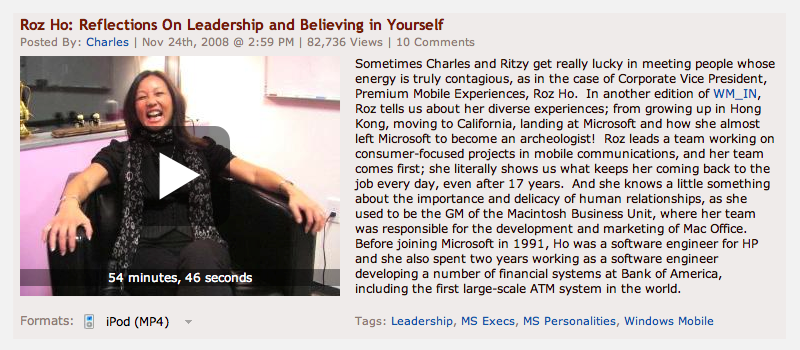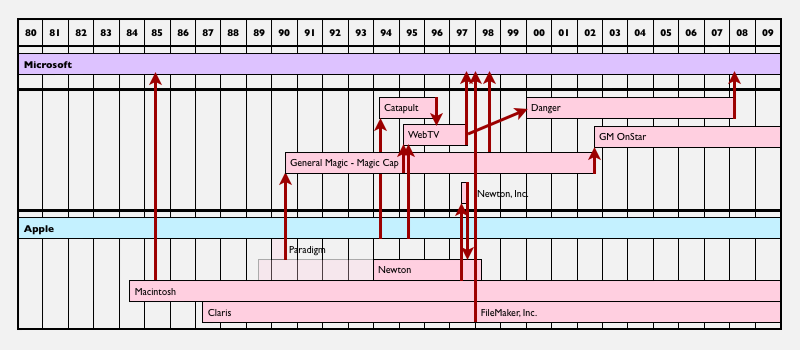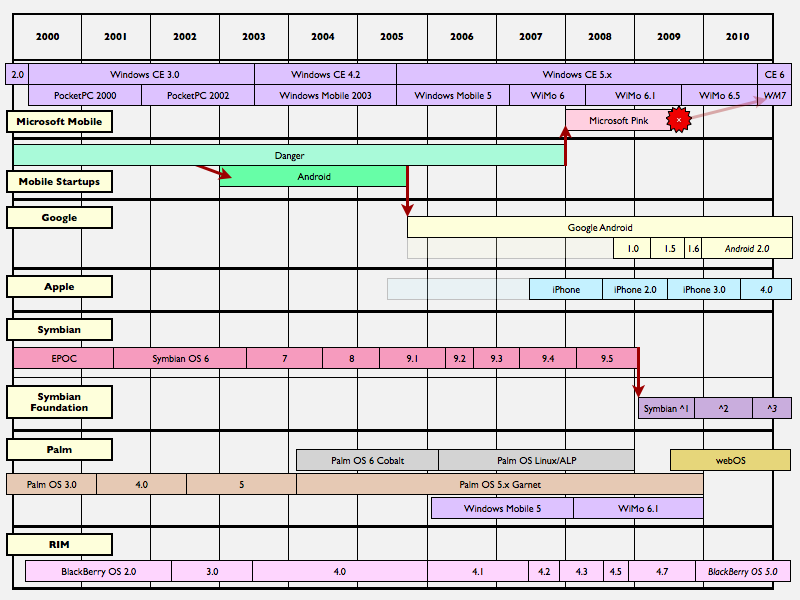Exclusive: Pink Danger leaks from Microsoft's Windows Phone
The initial report, published by Greg Kumparak of MobileCrunch, was based on an anonymous source "with a seemingly exhaustive knowledge of Microsoft’s Project Pink." According to that tipster, the project is in disarray, with "no braintrust that understands how to build a product." Efforts to build a third party software platform for Pink are also in trouble because "team members don’t know how to get it done," the source claimed, with remaining employees complaining that they "hate the product" they're working on and feel like it was "never intended to ship," but that it only existed to "challenge [the Windows Mobile 7 team] and upset them into competing."
The report is bad news for Microsoft given that less than two years ago it paid a reported $500 million to acquire Danger, the developer behind the T-Mobile Sidekick. Microsoft's 2008 acquisition of the company was initially seen as an effort to breathe life into its struggling Windows Mobile division, which had been rapidly losing smartphone market share to RIM's BlackBerry in the enterprise and Apple's iPhone among consumers.
It was later revealed that Microsoft had converted Danger into "Pink," a top secret project operating independently from Windows Mobile, with the intent of directly challenging the iPhone. This mimicked Microsoft's earlier strategy of launching the Zune against Apple's iPod, which the company did while assuring its PlaysForSure hardware and music store partners that Zune wouldn't have any impact on their existing business. As it turned out, Zune had no impact on the iPod but completely destroyed the remains of Microsoft's PlaysForSure partnerships.
Our inside source now says the same thing is happening to Pink, even before Microsoft can finish it (jump to page 3 to read their letter). That's particularly problematic because Microsoft is already facing a schism between its Windows Mobile and Zune platform groups, their differing first party software development, and their business models for third party software and software stores.
Windows Mobile vs the Zune
Microsoft worked to keep Pink a secret, and its chief executive Steve Ballmer
There is only minimal overlap between the two platforms; Windows Mobile 6.5 has borrowed some of the Zune's menu designs, but the Zune is built around a touch-based interface while Windows Mobile retains a core dependence upon a stylus. According to reviewers, Windows Mobile is actually impossible to use without a stylus. And while Microsoft is now branding any smartphone running its software as a "Windows Phone," it has taken great pains to avoid associating the Windows brand to the Zune.
Microsoft's strategy is markedly different than Apple's, which presents the iPhone and iPod touch as being nearly identical both in hardware and software, with the only real difference being that the iPhone supplies a cellular radio, a compass, GPS, and a camera. Both share the same media formats, software titles, online stores, hardware accessories, the same development tools, and are built around the same multitouch interface with an identical look and feel. Apple even refers to the current operating system of both devices as being "iPhone 3.1 software."
Dangerous Liaisons: Pink vs Windows Mobile
Rather than melding Windows Mobile with the Zune to create a cohesive mobile platform like Apple, Microsoft moved in the opposite direction. The Danger group Microsoft acquired was run autonomously, creating a third fiefdom competing for attention and resources within the company.
Unlike Windows Mobile and its cousin the Zune, which are both based on the Windows CE operating system kernel and shared components above that, Danger's smartphone platform was based on a Java virtual machine running on top of a NetBSD kernel, although the Danger OS supplied its own proprietary APIs for developing mobile apps in addition to support for standard J2ME. That radical difference in operating system and application technology meant that Microsoft was unlikely to simply rebrand Danger's phones as its own; instead, the company announced that it only would be using some of Danger's ideas to build an entirely new "experience."
Danger was rolled into Microsoft's Premium Mobile Experiences group led by Roz Ho, who formerly ran Microsoft's Mac Business Unit. "We imagine a mobile experience that embraces sharing and celebrating relationships and personal moments,†Ho said in a press release. “Combining Danger and Microsoft talents together in the Premium Mobile Experiences team is how we’re going to deliver cool, new, fun mobile experiences to consumers. We want people to smile every time they look at their phone.â€
Roz Ho's Pink Project
Ho, a 17 year veteran of Microsoft, works in a pink office (with the word "pink" actually painted on the wall). In a video published by Microsoft's Channel 9, Ho told her interviewers she was "having fun every day" and said her excitement about consumer products led to Microsoft assigning her the task of setting up a team of twelve to figure out how the company could best reach consumers in the smartphone arena. Ho said that her team was responsible for identifying and purchasing Danger, which brought 300 people into Microsoft from the company. Her team was later joined by an additional 200 employees working on the Pink project.
On camera, Ho declined to say anything specific about what her group was working to create. When asked why her office was pink, she laughed and said, "Actually I can't tell you!"
On page 2 of 3: Danger and iPhone, Android.
Danger was originally founded in 2000 by three late 80s veterans of Apple: Andy Rubin, who left Apple to join its General Magic/Magic Cap spinoff (which later licensed its pen-based technology to Microsoft in 1998), then started up WebTV (which was acquired by Microsoft in 1997), before co-founding Danger; Joe Britt, who got started working for Apple at 19, then moved to Catapult Entertainment (a video game developer started by Apple employes) and then to WebTV and then Danger; and Matt Hershenson, who worked on the design of Apple's PowerBook 150 and prototypes of the company's iTV set top box (which never made it into production) before working for Catapult and then Phillips before co-founding Danger.
As a company, Danger worked closely with Flextronics and later Japan's Sharp Corporation to develop its Hiptop line of smartphones, which tightly integrated into the company's own operating system, much like the iPhone would later do. Its first model shipped in 2002, making it one of the first smartphones on the market and among the most popular sophisticated phones to be sold in the US, where it was exclusively marketed by T-Mobile as the SideKick (similar to how Apple partnered with AT&T to delver the iPhone). Since 2004, Danger has worked closely with Sharp to develop a series of GSM/UMTS Hiptop/Sidekick phones for sale in the US, Canada, Australia, and Europe.
Danger also pioneered direct software downloads through its innovative Download Catalog, a model later followed by Apple's iPhone App Store. Like Apple currently does, Danger tightly controlled what software could be installed on the device by encrypting apps in the store and preventing the casual installation of any unsigned apps. This was done to set a high bar for software quality and to tie software titles to compatible releases of the operating system by version.
Danger's innovative business model and its popularity among young users (who were drawn to its pioneering ability to support AOL instant Messaging) left some observers to predict that Apple would acquire the company in order to build its rumored iPhone. Instead, Apple developed its own hardware design deeply integrated with a mobile-optimized version of Mac OS X. And while Apple copied Danger's software distribution model, it developed its own unique multitouch interface rather than using a Hiptop-style thumb-based keyboard.
Danger and Android
In 2003, a few years after founding Danger, Andy Rubin left to start a new project called Android. He was joined by two other co-founders who had worked with him at WebTV, Andy McFadden and Chris White, along with an executive from T-Mobile, Richard Miner. Twenty-two months later, Google acquired the Android project in August 2005, signaling its interest to enter the smartphone business.
Just over a year later when Apple introduced the iPhone, rumors began to fly that Google's Android group would be bringing its own "GPhone" to market as an iPhone-killer. Instead, Google announced in November 2007 that Android would be an open platform that other hardware makers could license for free to build their smartphones.
This strategy pitted Android against Microsoft's Windows Mobile in a defensive play to prevent Microsoft from leveraging its smartphone hardware partnerships to block Google's entry into the mobile search and ads business. Insiders have referred to Android as "Danger 2.0," as the Android project builds upon Danger's general architecture of using a Unix-like kernel (Android uses Linux) with a Java-like application runtime (Android's Dalvik virtual machine).
As the iPhone began rapidly eating up the consumer market in its first six months, and as Google's Android loomed as a direct threat to the licensing model of Windows Mobile, Microsoft bought up the struggling Danger and set out to use the company to target the consumer market, something Windows Mobile had never successfully done. Microsoft's existing clients were primarily Windows IT shops, and even that market was under intense competitive pressure from RIM's BlackBerry.
On page 3 of 3: Microsoft's grave Danger from poisonous leaks.
With that background on Danger and Pink, the new leaks supplied by our non-anonymous Microsoft/Danger insider will make more sense. "I honestly have no idea who leaked the damaging details to MobileCrunch about "Pink", but since the cat's out of the bag, allow me to add a little context to the story for your readers," the source wrote.
"First, all of the details are true. I wouldn't be surprised if the leaked photos of "Pure" and "Turtle" were an intentional leak by Microsoft (it seems like the sort of thing they would do), but the new details leaking the Pink project partners and the dirty laundry about dissent at Danger are clearly the work of an extremely disgruntled former or current employee.
"I have my share of disgruntlement about the situation, but it never occurred to me to do something like that. This is actually the worst possible timing for Microsoft for this information to come out (on the heels of the awful reviews of WM 6.5), and I suspect that it has already caused irreparable damage to their relationships with a number of key partners, to which I say, 'Bravo, leaker, well played.' Now allow me to twist the knife...
The Pink partners in Danger
"Let's start with the handset makers. Motorola has announced their intention to abandon WinMo for Android, and Palm has already abandoned WinMo in favor of their own WebOS. A few others, such as HTC, have been hedging their bets, announcing their support for Android, but not yet willing to publicly disown WinMo. Now the story has been leaked that Microsoft has been secretly working with Sharp on this (doomed) [Pink] project for over a year, cutting everyone else out of the picture completely.
"You figured out the likely consequences of this over a month ago so I won't belabor the point other than to say that Sharp, who has been a terrific partner to Danger throughout the Hiptop/Sidekick era, was no doubt hoping that Pink would allow them to expand their phone offerings in the Americas, a dream which has now been dashed due to typical Microsoft blundering. I doubt that either Sharp or any of the other handset OEM's will ever take Microsoft at their word again.
"Now, the mobile operators. Verizon is no doubt pissed to see their name leaked in relation to this sorry situation. Fortunately, they have been hedging their bets with their recent Android announcements, and I wouldn't be surprised if the rumors about them working with Apple on a CDMA iPhone were true as well. They've had great success with RIM phones and could also easily ship a WebOS phone, which already runs on CDMA. The one thing they would no doubt like to avoid at all costs is further dependence on WinMo, which apparently has a 25% return rate for dissatisfaction at their stores.
"If any Sidekick device had even a small fraction of this return rate, heads would have rolled! Clearly Verizon was hoping that Pink would be a different story. I've even heard of representatives saying things like 'we can't believe this is coming out of Microsoft' after a successful Pink demo, a quote that was reported to us by the Microsoft representative without any acknowledgment of the backhanded nature of that 'compliment.' No doubt whoever said that has now realized that it is in fact Microsoft, and that demos can be quite deceiving.
The problem of four Pinks
"There were other operators involved in the project because (and this hasn't leaked yet), in their infinite wisdom, the Pink planners decided to try to build both UMTS and CDMA phones in both form factors, for a grand total of four different SKUs.
"None of the other smartphone platform builders were foolish enough to try to build more than one phone at a time, and whoever made this decision didn't take into account the added complexity involved in coding to support two different radio modules (from two different vendors, no less!) for two completely different radio technologies, not to mention validating and testing the RF performance of four different antennas (since each form factor and radio technology requires its own antenna design).
"You could have picked anyone at random from Danger and asked them if this would be a good idea and gotten the correct answer (hell no!), but by the time we were brought in, these decisions had already been made. At some point the UMTS project was placed on the back burner, and for all I know it may have already been cancelled, but the damage to the project has been done.
Pitting Verizon against T-Mobile
"The final operator who is going to be pissed is T-Mobile, who has been just as loyal of a partner to Danger as Sharp has been. I don't know exactly what Microsoft has been telling them, but they have no doubt realized that they've been cut out of this deal in favor of their largest competitor. What's worse is that apparently Microsoft has been lying to them this whole time about the amount of resources that they've been putting behind Sidekick development and support (in reality, it was cut down to a handful of people in Palo Alto managing some contractors in Romania, Ukraine, etc.).
"The reason for the deceit wasn't purely to cover up the development of Pink but also because Microsoft could get more money from T-Mobile for their support contract if T-Mobile thought that there were still hundreds of engineers working on the Sidekick platform. As we saw from their recent embarrassment with Sidekick data outages, that has clearly not been the case for some time.
"So now that the whole thing has blown up in their faces, I'm not sure what will happen next. Fortunately it doesn't affect me since I've already left, but I feel sad that so many Danger folks who I respect deeply are still working there, and none of them were responsible for making these catastrophic decisions. The most likely possibility is that anything worth salvaging from Pink will get folded into the larger WiMo 7 project, where it should have been located in the first place.
"Instead, Pink was a skunkworks project kept completely secret from both the WinMo and Zune teams, which led to much frustration and duplication of effort. Of course WinMo is so screwed that this will likely lead to still more Danger folks quitting in disgust. Another possibility would be another massive layoff and shutting down the Danger offices, but with the economic crunch, I doubt that Microsoft would choose to take the hit of handing out severance packages to all the affected engineers, and breaking the lease on the buildings.
"The smartest course of action (and therefore the one that Microsoft is least likely to take!) would be for them to recognize the value of the original Danger platform that they acquired, and to rebuild the Hiptop/Sidekick into a force to compete with Android (which is, after all, "Sidekick 2.0" in many respects). This won't happen for three reasons: 1) Microsoft's irrational hatred of Java, 2) Microsoft's irrational love of Windows in all of its horrible flavors, and 3) all the Danger folks who loved the Sidekick platform have left or likely will leave soon, and Microsoft has no in-house expertise in Java or the Danger platform.
Heave Ho
"Finally, assigning blame. The original leaker didn't discuss the personalities involved, but clearly the executive most responsible is Roz Ho, head of PMX [Premium Mobile Experiences]. I don't dislike her personally (I never met her personally, and she has no idea who I am anyway), but she was clearly incompetent to head this project, and was not humble enough to actually listen to what all the Danger folks were screaming about and to change course before things had gotten to this point.
"She was also responsible for the "Pink" codename, which has a lamer backstory than anyone has guessed: she was listening to a song by Pink (the singer) when she decided she was just the person to go one-up the Sidekick. To her credit, I wouldn't say that she is any more incompetent than the fools above her in the org chart: Andy Lees, Robbie Bach, and of course Steve Ballmer.
"I always figured that she was guaranteed to 'fail upward' with this project, assuming that anything at all shipped as Pink v1 (no matter how crappy), but with this recent MobileCrunch leak, and my 'twisting the knife,' perhaps there will be some accountability after all and she will have to fall on her sword. The smart thing would be for the board to fire all of the people I listed, along with Ray Ozzie and Craig Mundie for good measure (two 'visionaries' who seem to be anything but), and then put someone like Steve Sinofsky in charge as interim CEO until things get sorted out. Of course this won't happen either."
Dismal prospects for a Microsoft mobile
With even Gartner now predicting that Windows Mobile likely has less than a year of life left in it, the failure of Pink only complicates Microsoft's already disastrous mess of mobile operations. Stuck between its efforts to sell a software platform that competes with free open source alternatives including Symbian and Android on one hand, and selling integrated solutions that take aim at successful single vendors such as RIM and Apple on the other, Microsoft has effectively shut itself out of the mobile business.
That misstep will provide RIM, Apple, Google, Nokia, and even Palm with easy access to pillage the remains of Microsoft's mobile business long before the company can mount any effective defense. Outside of the mobile business itself, that means Microsoft will also have little leverage to push its desktop technologies into the mobile frontier, from Bing search to Silverlight and .NET development. This also has other implications related to mobile clients, ranging from messaging platforms to cloud computing.
On the bright side, this affords Microsoft the opportunity to focus on providing cross platform software solutions to the successful mobile platforms, allowing the software giant to sell its Exchange ActiveSync and mobile versions of its Office titles to users of all different platforms rather than feeling the need to keep these exclusive to its own platform. In fact, the company has already broadly licensed ActiveSync to other mobile makers and has recently announced new Office mobile software under development for Symbian users.
Daniel Eran Dilger is the author of "Snow Leopard Server (Developer Reference)," a new book from Wiley available now for pre-order at a special price from Amazon.
 Daniel Eran Dilger
Daniel Eran Dilger














 Mike Wuerthele
Mike Wuerthele
 Malcolm Owen
Malcolm Owen
 Chip Loder
Chip Loder

 William Gallagher
William Gallagher
 Christine McKee
Christine McKee
 Michael Stroup
Michael Stroup
 William Gallagher and Mike Wuerthele
William Gallagher and Mike Wuerthele






